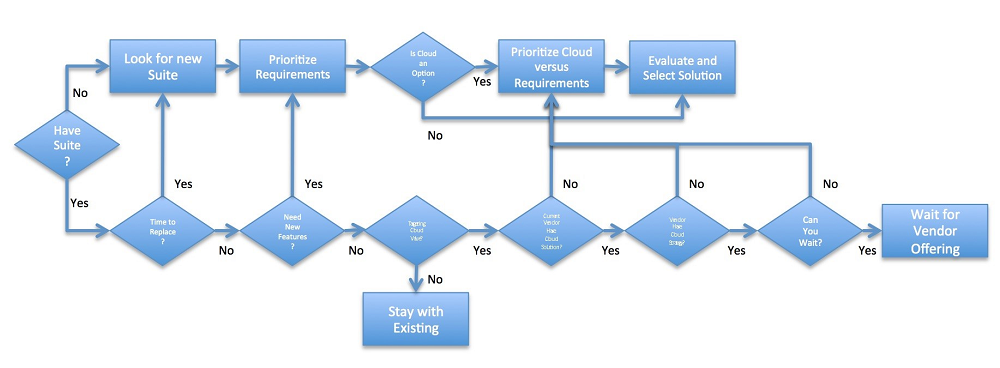The subtle shift to “why not cloud?”

Why use the cloud?
Traditionally, manufacturers asked us why they should consider using engineering software on the cloud. They were comfortable with software on their desktops or on their own servers. They had concerns about the cloud, it sounded risky and cloud computing in business was unproven.
At the same time, we saw their companies transitioning applications that hold critical business data, including enterprise financials and customer data, to the cloud. Our research and observations also showed that engineers were using cloud storage solutions like Dropbox or Google Drive to store and share their engineering information. They were already starting to use the cloud, even if informally. But, when we asked them how they felt about using the cloud to support product innovation and engineering, they had reservations ranging from performance concerns to IP protection.
Cloud computing in business: that was then
As early as five years ago we found that the vast majority of manufacturers were open to cloud solutions. In fact, top performing product innovators were twice as likely to be using the cloud, although not necessarily for engineering solutions.
Since that time, we’ve seen some companies transition to a “cloud first” mentality. These companies have made a decision to select, or at least favor, cloud solutions whenever they are available. In fact, we speak with many startups that take a “cloud only” approach. For them, cloud computing in their business isn’t just an option, it’s the only option.
But it’s important to recognize that cloud and traditionally deployed solutions aren’t necessarily equal. We find that deployment options are typically a lower priority than ensuring that an engineering software has the right functionality. After all, the solution is enabling company innovators, a mission critical need!

Understanding slower adoption in engineering
Industry research showed a slower adoption curve for engineering solutions than for other applications. Some believe that the lower speed of cloud adoption of in engineering was because of security concerns, that companies were simply uncomfortable putting their intellectual property on the web.
Security is certainly important, and should be addressed by selecting a trusted partner and ensuring performance with standards and audits. But most companies we spoke with admitted that cloud providers were probably better at managing security than they were, anyway.
We see it differently. We believe that the lack of adoption was, at least partially, because equivalent solutions simply didn’t exist. The solutions on the market were valuable, but covered a different scope. They didn’t provide the rich array of design capabilities designed to support unique needs of product innovation and engineering. There were no apples to apples choices for design, simulation, data management or managing the product lifecycle on the cloud versus on-premises.
It’s also important to recognize that once engineering solutions are in place, it’s typically a major investment to change them. Companies often have to invest significantly in process development, training and integration when they change solutions. That also serves as an opportunity to improve for the better, but it has a cost. Because of this, companies are typically hesitant to make significant changes to their chosen solutions.
We offered advice to companies considering new product innovation and engineering solutions, including cloud (see the flowchart below). The bottom line is that it made sense for many companies to stay with what they have and wait for the eventual evolution to the cloud.
As we discuss in Exploring Cloud Options for Product Innovation and Development, “The right strategy depends on the scope you want to deploy and how to best achieve it. Few companies ‘rip and replace’ existing solutions to get to the cloud. So the strategy typically involves a function of what your enterprise is ready for and what your chosen vendor supports.”

Cloud computing in business: this is now
Now, the market has shifted. There are still a number of cloud-only vendors offering engineering software. These companies have matured, and many have shifted priorities away from engineering-centric solutions to offer more enterprise and supply chain focused capabilities.
At the same time, more companies are offering a choice of deployment options. Some of the traditional solution providers with highly capable solutions, including Siemens, are making a transition. In many cases they’re offering a combination of cloud deployment and purpose-built product innovation and engineering functionality. This combination promises to open up the cloud opportunity to many more companies.
But, why cloud?
Circling back to the original question companies asked, why should a manufacturer consider a cloud solution?
Companies don’t make major IT shifts without a reason, whether strategic in nature or ROI-driven. The cloud offers a lot of reasons to change. For example, our research shows benefits along five dimensions:
• Implementation Benefits, including the ability to start fast without the need to purchase and install servers or add IT resources
• Operational Benefits, like focusing on innovation instead of backing up data and managing performance
• Business Benefits, such as cost savings, lower risk, and scalability
• Unique Benefits for Engineering Software, including the ability to better support remote engineering locations or leverage unlimited computing power for capabilities like generative design
• Strategic benefits, for example supporting digitalization and connecting digital twins with their physical counterparts over the IoT
So, why not Cloud?
Times have changed and so have opinions about product innovation and engineering software in the cloud. The sentiment around cloud computing in business is more favorable now that companies have gained more experience and learned how to manage cloud providers. The benefits are compelling, ranging from one-time implementation benefits to enabling highly strategic digitalization initiatives.
The appetite for cloud solutions is increasing. At the same time, options are expanding to include more traditional solutions, along with their deep functionality, in a cloud offering. It’s time for more companies to take a look.
This concludes the first part in our series on the benefits of the cloud in your business. Stay tuned for additional posts on this topic. In the meantime, please visit our cloud page.
About the author
Jim Brown is the founder and president of independent research firm Tech-Clarity. He is a recognized expert in enterprise software for manufacturers with more than 25 years of experience in application software, management consulting and research. He has extensive knowledge about how manufacturers use product lifecycle management and other enterprise applications to improve business performance, and he’s actively researching the value from new initiatives and technologies, including cloud computing, digitalization, product innovation platforms, smart manufacturing, AR, VR, and the IoT, in addition to his core research areas. He began his career in manufacturing engineering and software systems at General Electric before joining Andersen Consulting (Accenture). He subsequently served as a strategy, marketing and product development executive for software companies specializing in ERP, PLM, Supply Chain and related manufacturing solutions. Jim is also author and speaker and enjoys participating in conferences and anywhere he can engage with people with a passion to improve business performance through digital enterprise strategies and supporting software technology.



Comments